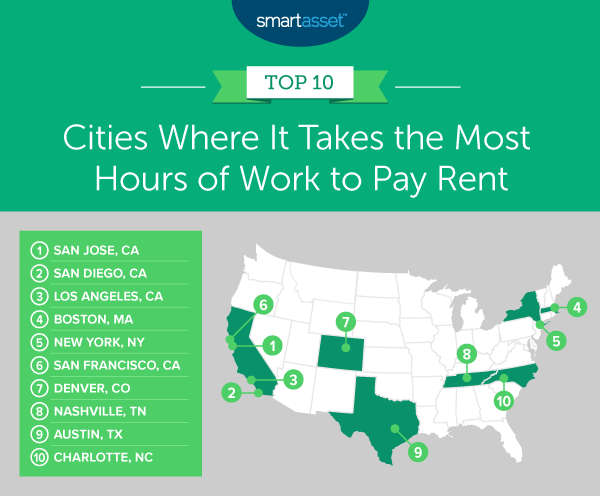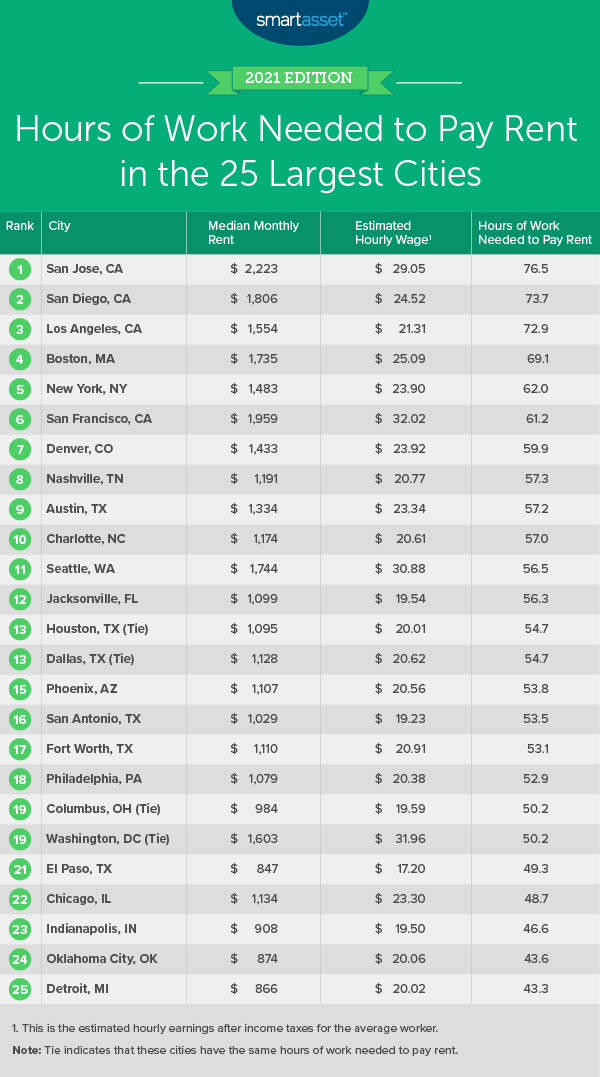According to the Census Bureau, almost 20 million renters allocate at least 30% of their household income towards rent, indicating that they are housing cost-burdened. This can be especially true in larger cities where the cost of living is higher. And if time is money, then many Americans will have to resort to working longer hours to make ends meet without having to use up any existing emergency funds.
In this study, SmartAsset measured the hours of work needed to pay rent in the 25 largest cities in the U.S. To determine our estimates, we considered data on the following metrics: average annual take-home pay, average hours worked per year and median monthly rent. For details on our data sources and how we put all the information together to create our final rankings, check out the Data and Methodology section below.
This is SmartAsset’s fourth annual study on the hours of work needed to pay rent. Check out the 2020 version here.
Key Findings
- 56.6 hours. The average number of work hours needed to pay rent across the largest 25 U.S. cities is 56.6. In the six cities at the top of our list, renters must work at least 6% longer to pay rent alone. It takes more than 60 hours of work in all six cities to cover average rental costs.
- California cities stay at the very top, but Los Angeles drops for the first time in recent years. In every version of this study since 2018, the three cities where the average worker needs to work the most to pay rent have been as follows: San Jose, Los Angeles and San Diego, California – in that order. In this year’s study, however, San Diego jumps to the No. 2 spot and Los Angeles drops to No. 3.

1. San Jose, CA
In San Jose, California, it takes more than 76 hours of work on average to pay median monthly rent, which is $2,223 or almost $26,700 per year. The median worker earns $41,419 after taxes, with an estimated hourly wage of about $29.
2. San Diego, CA
The average annual take-home pay in San Diego, California is $34,157, or an hourly wage of less than $25. According to our estimates, the average worker in this city would need to work almost 74 hours to be able to pay a month’s rent, which is $1,806.
3. Los Angeles, CA
In Los Angeles, California, the average worker needs to clock almost 73 hours to cover median monthly rent, which is $1,554. The average number of hours worked in the city is about 38 hours per week, which means that it would take this person almost two weeks to cover that total amount of time. The average worker in Los Angeles earns $34,669 before taxes and takes home about $28,815 – or a little more than $21 per hour.
4. Boston, MA
In Boston, Massachusetts, the average worker earns $35,800 after taxes, or about $25 an hour. The median monthly rent in Boston is $1,735, which means residents there will have to work more than 69 hours to pay for a month’s rent. At an average of about 38 hours worked per week in Boston, it would take nearly 13 days for a worker to cover this amount.
5. New York, NY
New York City has the fifth-highest number of hours needed to pay rent across the 25 largest cities in this study. With a median monthly rent in the city of $1,483, a worker person would have to work 62.0 hours to cover rent. The average worker in New York earns $42,326 and takes home $32,608 after taxes, or $23.90 per hour.
6. San Francisco, CA
In San Francisco, California the median monthly rent is $1,959. This is the second-highest monthly rent amount across all 25 cities in our study, following only San Jose, California. The average worker in the city earns about $32 per hour, or $51,548 after taxes. This means that the worker would have to work 61.2 hours to cover rental costs. At an average of 40.2 hours worked per week in San Francisco, it would take this worker about a week and a half to do so.
7. Denver, CO
In order to cover the costs of the average rental apartment or home in Denver, Colorado, the average worker would need to work almost 60 hours. The median monthly rent in Denver is $1,433. The average worker in Denver earns $47,146 before taxes, with a take-home pay of $37,922 or $23.92 an hour.
8. Nashville, TN
The median monthly rent in Nashville, Tennessee is $1,191 or $14,292 per year. With the average worker there earning $31,889 after taxes or $20.77 per hour, it would take him or her approximately 57 hours of work to cover the cost of rent each month.
9. Austin, TX
The average worker in Austin, Texas earns $42,416 and takes home $35,739 or $23.34 per hour. Monthly rent costs in Austin reach $1,334 per month, or $16,008 per year. At that rate, it would take this worker more than 57 hours to cover rental costs.
10. Charlotte, NC
Median earnings for a worker in Charlotte, North Carolina are $38,528. This worker would take home $31,118 or $20.61 an hour. Charlotte has the lowest median monthly rent across the 10 cities on this list, at $1,174, resulting in a total annual rent of $14,088. To be able to pay for a month’s rent in Charlotte, the average worker would have to work 57 hours.

Data and Methodology
To find out how many hours of work are needed to pay rent in the 25 largest cities in the U.S., we looked at data on the following three metrics:
- Average annual take-home pay. This is the average worker’s earnings after accounting for income taxes. To find out how much each worker would pay in income taxes, we ran median worker’s earnings data through our income tax calculator. We assumed the average worker would contribute nothing to an IRA or 401(k), take the standard deduction and file as a single filer. Earnings data comes from the U.S. Census Bureau’s 2019 1-year American Community Survey.
- Average hours worked per year. This is the number of weeks worked per year multiplied by the number of hours worked per week. Data comes from the U.S. Census Bureau’s 2019 1-year American Community Survey.
- Median monthly rent. Data comes from the U.S. Census Bureau’s 2019 1-year American Community Survey.
First, we found the average hourly wage for each worker by dividing average annual take-home pay by average hours worked per year. Then we divided the monthly median monthly rent by the average hourly wage. This resulted in the average hours of work needed to pay a month’s rent. Finally, we ordered the cities from highest to lowest based on the average number of hours needed to pay rent.
Tips for Managing Your Savings
- How much are you really taking home? When budgeting how much to allocate to needs, wants and savings, it’s important to know how much you’re actually starting with. Use SmartAsset’s paycheck calculator to find out your post-tax earnings.
- Budgeting is key. If the cost of living in an area is high and moving is not an option, consider using our online budget tool to make sure your expenses are all covered.
- 401(k) matching. Taking advantage of a 401(k) employer match program is an ideal way to build your retirement savings faster. When considering a new job always review the retirement plan offerings to be sure that it’s the right one for your needs.
- Expert financial advice. You already work hard to make ends meet, so why put in any more hours than you need to in order to get expert help with your assets? Finding the right financial advisor doesn’t have to be hard. SmartAsset’s free tool matches you with financial advisors in your area in five minutes. If you’re ready to be matched with local advisors that will help you achieve your financial goals, get started now.
Questions about our study? Contact press@smartasset.com.
Photo credit: ©iStock.com/mphillips007
